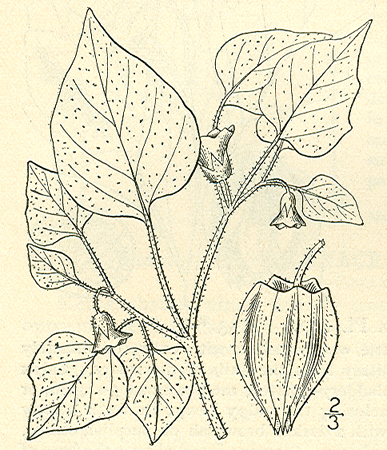
Synonymy
*Physalis pubescens L., Sp. Pl. 1: 183 (1753)
T: "Habitat in India utraque." Lectotype : Herb. Linn. No. 247.11 (LINN) fide Waterfall in Rhodora 60: 165 (1958). See The Linnaean Plant Name Typification Project pages on the Natural History Museum site.
A specimen bearing this name (microfiche number IDC 89.15) in the Linnaean Herbarium in Stockholm can be seen at http://linnaeus.nrm.se/botany/fbo/p/physa/physpub.html.en
Description
Annual to 50 cm, pubescent with glandular and simple, non-glandular hairs.
Leaves alternate; lamina ovate to ovate-elliptic, cordate at base, up to 10 cm (usually c. 6 cm) long, toothed or with obtuse, triangular lobes; petiole to 7 cm long.
Pedicels 5–10 mm long. Calyx 6–7 mm long; lobes narrowly triangular, 3–4 mm long. Corolla 5–angled 7–11 mm long, dull yellow with 5 distinct purple-brown spots towards base. Anthers 1.5–2 mm long. Style 4–5 mm long.
Fruiting calyx prominently 5–angled, 25–40 mm long, very pale yellow-green, drying to light brown. Berry globular to ovoid, 12–15 mm diam. Seeds disc-shaped, 1.5 mm long, light brown.
Distribution and ecology
Native to USA through to Argentina and West Indies, in Australia this is an uncommon weed known from isolated localities in Vic. and south-western W.A.
Notes
A table showing differences between some of the commoner groundcherry species, including this one, can be seen at www.cdfa.ca.gov/phpps/ipc/weedinfo/physalis-table.htm
Distinguishing characteristics for this species are the dark blotched yellow corollas, purple to blue anthers and the hairy, strongly 5-angled fruiting calyces. A description of the species can be found in Martinez (1998) together with a line drawing and a map of its natural distribution. The fruit is eaten in many of the countries where it is native and it is reputed to have some medicinal properties.
Martinez, M. (1998). Revision of Physalis Section Epeteiorhiza (Solanaceae). Anales del Instituto de Biologia Universidad Nacional Autonoma de Mexico Serie Botanica 69: 71-117.
Selected specimens
W.A.: Bowelling, 20 Feb. 1959, J.D. Price (PERTH). Vic: near Dimboola, 20 Mar. 1898, Anon. (MEL).
Derivation of epithet
From pubescens, Latin for hairy.
Images and information on web
Information about Physalis species as weeds in California can be found on the Encycloweedia pages at www.cdfa.ca.gov/phpps/ipc/weedinfo/physalis.htm
Further information and links for P. pubescens can be found on the Plants for A Future site at www.ibiblio.org/pfaf/cgi-bin/arr_html?Physalis+pubescens&CAN=LATIND
Images of the plant can be seen at the Nearctica site at www.nearctica.com/flowers/otos/solan/Ppubes.htm and a series of detailed images at the Missouriplants site at www.missouriplants.com/Yellowalt/Physalis_pubescens_page.html
Material in the Linnean Herbarium in Stockholm can be seen at http://linnaeus.nrm.se/botany/fbo/p/physa/physpub.html.en
Information on this species in NSW can be seen on the PlantNet site at http://plantnet.rbgsyd.nsw.gov.au/cgi-bin/NSWfl.pl?page=nswfl&lvl=sp&name=Physalis~pubescens
Information about the possible toxic properties of Physalis species can be found with a search in the FDA Poisonous Plant Database
Information on the value of the fruits of P. pubescens has been published by El Sheikha A. & Montet D. (2008). Physico-chemical properties and biochemical composition of physalis (Physalis pubescens L.) fruits. Food 2(2): 124-130. Abstract
Note: with the confusion surrounding the application of names in Physalis, information given on the web which is species specific should be viewed with some caution.